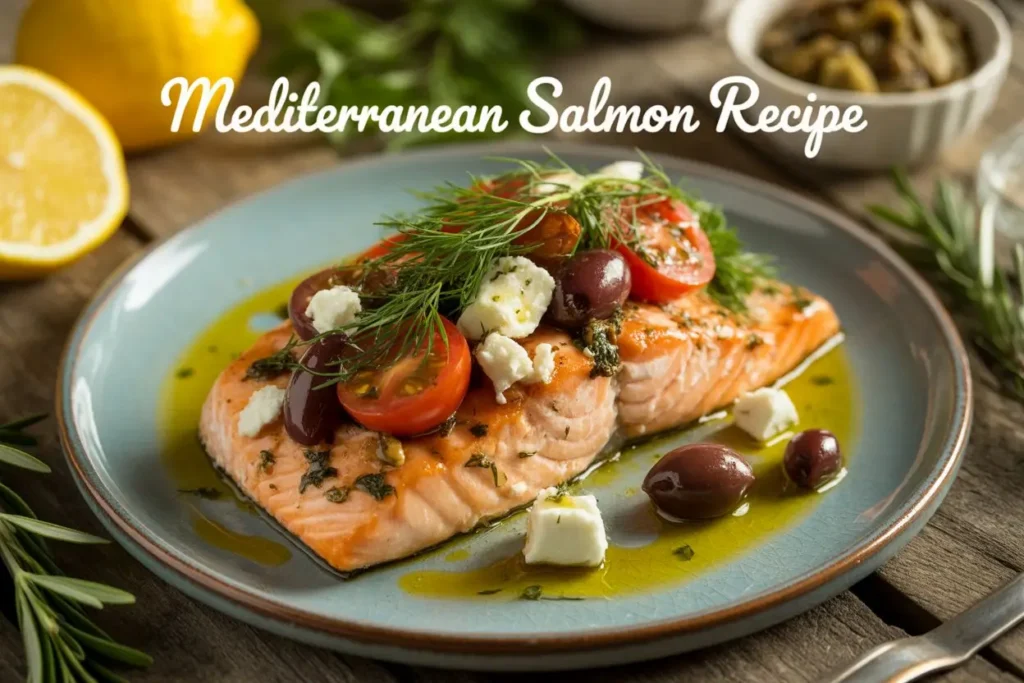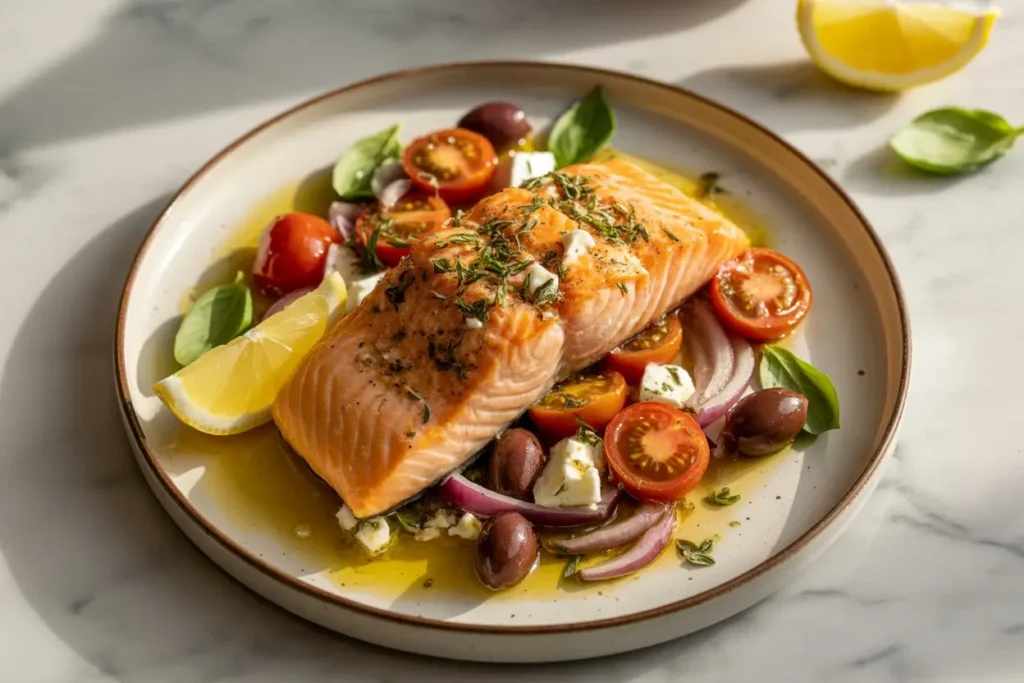If a 25 minute mediterranean salmon delivers around 1.8 grams of omega 3s per serving and meets the twice weekly fish target many experts recommend, why do so many home cooks still think seafood is complicated? This recipe proves otherwise, with bright flavors, simple steps, and consistent results you can repeat any night of the week.
Introduction
The most common reasons people avoid cooking fish at home are overcooking fears, lingering aromas, and uncertain seasoning. All three are easy to fix. A balanced Mediterranean profile of lemon, garlic, oregano, and extra virgin olive oil gives salmon a savory lift while keeping the method simple.
This approach highlights what salmon already does well. It sears and roasts quickly, pairs with tomatoes, olives, and feta, and carries citrus and herbs beautifully. You will use one pan, reach ideal doneness with a quick thermometer check, and deliver a restaurant level plate with pantry staples and a few fresh vegetables.
Ingredients for mediterranean salmon
The aromatics and produce here are flexible. The core is salmon, olive oil, lemon, garlic, and herbs. Everything else adds color, texture, and a salty pop.
- 4 salmon fillets, 5 to 6 ounces each, skin on if possible
- 2 cups cherry or grape tomatoes, halved
- 1 small red onion, thinly sliced
- 1 red bell pepper, sliced into strips
- 1 small zucchini, sliced into half moons
- 1/2 cup pitted Kalamata olives, halved
- 2 tablespoons capers, rinsed
- 3 to 4 cloves garlic, minced
- Zest of 1 lemon, plus 2 tablespoons lemon juice
- 2 to 3 tablespoons extra virgin olive oil
- 1 teaspoon dried oregano
- 1/2 teaspoon smoked paprika
- 1/2 teaspoon kosher salt, plus more to taste
- 1/2 teaspoon freshly cracked black pepper
- Pinch of red pepper flakes, optional
- 1/2 cup feta cheese, crumbled
- Fresh dill and flat leaf parsley, chopped, for garnish
Substitutions that keep the spirit of mediterranean salmon intact:
- Fish: Steelhead trout or Arctic char cooks and tastes very similar. Cod works too, with 2 to 4 extra minutes of cook time.
- Olives: Castelvetrano olives for a milder, buttery bite.
- Herbs: Thyme or a small pinch of rosemary. Za’atar or sumac adds citrusy depth.
- Veggies: Artichoke hearts, asparagus, yellow squash, or sliced fennel.
- Dairy free: Omit feta and add toasted pine nuts for richness.
- Low sodium: Choose low salt capers and olives, and season the fish lightly, finishing with lemon instead.
Timing
- Prep time: 10 to 12 minutes
- Cook time: 12 to 14 minutes in the oven, plus 2 minute broil for finishing
- Total time: About 25 minutes, which is 15 to 25 percent faster than many baked fish recipes that run 30 to 35 minutes
Optional quick marinade: 15 minutes in the fridge with lemon, olive oil, garlic, oregano. Keep acidic marinades short to protect texture.
If you prefer an air fryer, plan on 8 to 10 minutes at 400 degrees Fahrenheit for 6 ounce fillets, depending on thickness.

Step-by-Step Instructions
Step 1: Heat the oven and prep the pan
- Preheat to 425 degrees Fahrenheit. A hot oven gives salmon glossy flakes and lightly blistered vegetables.
- Line a rimmed sheet pan with parchment for easy cleanup. If you prefer extra crisp edges on the vegetables, use bare metal and a thin brush of olive oil.
Tip: Preheating the empty sheet pan for 5 minutes jumpstarts browning on the vegetables.
Step 2: Season the vegetables
- On the pan, toss tomatoes, onion, bell pepper, and zucchini with 1 to 1.5 tablespoons olive oil, half the garlic, half the oregano, half the paprika, a pinch of salt, and black pepper.
- Spread in a single layer with space between pieces so they roast, not steam.
Tip: If your oven has convection, use it. Air movement improves caramelization and shortens cook time by a couple of minutes.
Step 3: Start the vegetables
- Roast the vegetables for 8 minutes while you prep the fish. They should begin to soften but still hold their shape.
Data-backed note: Most home ovens lose 50 to 100 degrees right after you open the door. Give them a head start to maintain the right heat profile for the salmon.
Step 4: Dry and season the salmon
- Pat salmon very dry, especially the skin, for crispness and even browning.
- Whisk lemon zest, lemon juice, 1 tablespoon olive oil, remaining garlic, oregano, paprika, red pepper flakes if using, and a pinch of salt and pepper. Brush over the salmon.
Tip: Salt the salmon lightly. Feta and olives add their own salt later, which keeps the final balance in check.
Step 5: Pan arrangement matters
- Pull the pan from the oven, add olives and capers to the vegetables, and toss.
- Nestle salmon fillets on top, skin side down. Leave at least an inch between fillets for even heat circulation.
Tip: Placing the fish directly on top of the veggies infuses flavor while shielding the fish from aggressive direct heat on the bottom.
Step 6: Roast to ideal doneness
- Return the pan to the oven and roast 10 to 12 minutes for 1 inch thick fillets. Thinner pieces may take 8 to 10 minutes.
- For a golden top, switch to broil on high for 1 to 2 minutes at the end. Watch closely.
Doneness guide:
- Pull at 120 to 125 F for medium rare, 130 F for medium, or 145 F for the USDA guideline.
- The fish should flake easily with a fork yet look slightly translucent in the center if aiming for medium.
Step 7: Finish with feta and herbs
- Sprinkle feta over the hot pan so it softens without melting completely.
- Shower with chopped dill and parsley. Squeeze a bit more lemon over everything if you like brightness.
Tip: Let the salmon rest 2 to 3 minutes so juices redistribute. This small pause keeps each bite silky.
Nutritional Information
Numbers below are estimates for one serving based on four portions from the recipe and typical values for Atlantic salmon. Actual values vary by brand and cut.
| Nutrient | Amount per serving |
|---|---|
| Calories | ~510 |
| Protein | ~43 g |
| Total fat | ~37 g |
| Saturated fat | ~8 g |
| Omega 3s (EPA + DHA) | ~1.8 g |
| Carbohydrates | ~10 g |
| Fiber | ~3 g |
| Total sugar | ~6 g |
| Sodium | ~680 mg |
| Vitamin D | ~15 to 20 mcg |
| Vitamin B12 | ~5 to 6 mcg |
| Selenium | ~70 mcg |
| Potassium | ~900 mg |
Why this matters:
- Salmon is rich in long chain omega 3s that support heart and brain health.
- The Mediterranean pattern favors olive oil, vegetables, and herbs, which fits current guidance that emphasizes unsaturated fats and plants.
- The dish is naturally gluten free and fits a low carb plate if you skip starches on the side.
Healthier Alternatives for the Recipe
Tailor mediterranean salmon to your goals without losing flavor.
- Lower sodium: Rinse capers, pick low sodium olives, and reduce feta to 2 tablespoons per serving. Finish with more lemon instead of extra salt.
- Dairy free: Skip feta and add toasted almonds or pine nuts for crunch and richness, or swirl on tahini sauce.
- Lighter fats: Reduce olive oil to 1 tablespoon for the vegetables and use a nonstick sheet pan. The fish has enough natural fat to stay moist.
- Extra vegetables: Add asparagus, broccolini, or cauliflower florets to push the vegetable share higher. Roast sturdy veg for 5 extra minutes before adding the salmon.
- Spice profile tweaks: Try za’atar, sumac, or a pinch of cumin. Fresh mint in place of dill shifts the flavor toward Greek salad vibes.
- Air fryer variation: Cook seasoned fillets skin side down at 400 F for 8 to 10 minutes. Roast vegetables separately or in batches to keep them crisp.
Dietary swaps:
- Low carb: Serve over cauliflower rice with chopped herbs and lemon.
- High fiber: Plate with quinoa tabbouleh or farro with parsley and cucumber.
- High protein: Add a dollop of Greek yogurt mixed with grated cucumber and garlic for an easy tzatziki style sauce.
Serving Suggestions
This is a full sheet pan dinner, yet a couple of smart sides turn it into a spread.
- Lemon orzo with parsley and a splash of the pan juices
- Herbed couscous or quinoa with chopped cucumber and tomato
- Crisp greens with a red wine vinaigrette
- Warm pita, hummus, and a quick tzatziki
- Roasted potatoes with oregano and lemon wedges
Wine and beverage pairing:
- Crisp white like Sauvignon Blanc or Greek Assyrtiko highlights citrus and herbs.
- A dry rosé works well with feta and olives.
- Sparkling water with lemon and a few crushed mint leaves for a clean nonalcoholic option.
Quick recap: Preheat hot, start the vegetables, season and dry the fish, roast to 125 to 130 F for tender flakes, finish with feta and herbs, and serve with something bright. When you try it at home, drop a rating or comment and subscribe for more weeknight friendly Mediterranean recipes.
Common Mistakes to Avoid
- Overcrowding the pan: Packed vegetables steam. Give them space to brown.
- Cold fish: Salmon straight from the fridge can seize and cook unevenly. Set it out for 10 to 15 minutes while the oven heats.
- Skipping the pat dry: Surface moisture blocks browning and crisp skin.
- Over-marinating in lemon juice: Acid can firm the surface if left too long. Keep marinades to 15 to 30 minutes.
- No thermometer: Visual cues help, but a quick probe thermometer removes guesswork. Aim for 125 to 130 F for medium.
- Too much salt early: Olives, capers, and feta all bring salt. Season lightly, then adjust at the end.
Data insight: Most salmon fillets vary between 0.75 and 1.25 inches thick. Each quarter inch can shift cook time by 2 to 3 minutes. Thickness matters more than weight.
Storing Tips for the Recipe
Leftovers are excellent, and flavor deepens by day two.
- Refrigeration: Store salmon and vegetables in an airtight container for up to 3 days. Keep herbs separate to add fresh at serving.
- Freezing: Cooked salmon freezes well for 2 to 3 months. Freeze in portions, wrapped tightly, and thaw overnight in the fridge.
- Reheating: Gentle heat is best. Warm at 275 F for 10 to 12 minutes or cover and microwave at 50 percent power in short bursts. For crisp skin, reheat the flesh side first, then finish skin side down in a lightly oiled skillet for 1 minute.
- Make ahead: Chop vegetables and mix the seasoning sauce up to 24 hours in advance. Toss veggies and roast when ready. Season the salmon just before it goes on the pan.
Meal prep idea:
- Pack bowls with quinoa, vegetables, and half a fillet. Add lemon wedges and a small container of herbs and feta to finish fresh at lunchtime.
FAQs
Q: Can I use frozen salmon?
A: Yes. Thaw overnight in the fridge or under cold running water in a sealed bag. Pat very dry before seasoning. Frozen fish can retain a little extra moisture, so broil briefly at the end to restore surface texture.
Q: Skin on or skin off?
A: Skin on helps insulate the fish and prevents albumin (the white protein streaks) from pushing out. It also crisps nicely when dried well and cooked hot. Remove the skin after cooking if you prefer.
Q: What temperature should I cook salmon to?
A: For tender, silky flakes, pull at 125 to 130 F. If you prefer firmer, go to 135 F. The USDA recommends 145 F. Residual heat will raise the temperature by a couple of degrees after you remove it from the oven.
Q: Can I grill this?
A: Yes. Preheat the grill to medium high. Oil the grates, grill the vegetables in a basket, and grill salmon skin side down for 6 to 8 minutes, then 2 to 3 minutes after a gentle turn. A cedar plank is a great option for gentle heat and easy handling.
Q: What if I do not eat dairy?
A: Skip feta and add a drizzle of tahini or a spoon of olive oil and toasted nuts. You will keep richness without dairy.
Q: What sides work for a low carb plate?
A: A big Greek chopped salad or roasted cauliflower with oregano and lemon keeps carbs low while keeping the bright flavors.
Q: Can I spice it up?
A: Add a pinch of Aleppo pepper or harissa to the seasoning mix. Both add gentle heat that fits the Mediterranean profile.
Q: Farmed or wild salmon?
A: Use what is available and fresh. Farmed Atlantic often has higher fat, which stays moist. Wild varieties tend to be leaner and cook a bit faster. Flavor is excellent either way when seasoned and cooked properly.
If this mediterranean salmon becomes a staple in your home, share a note or a star rating, and subscribe for more practical, flavor forward recipes that fit a busy weeknight.


